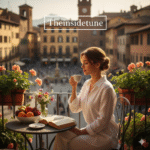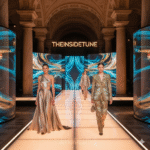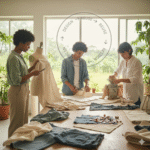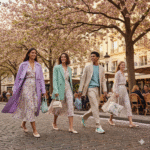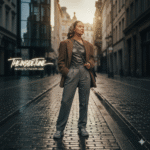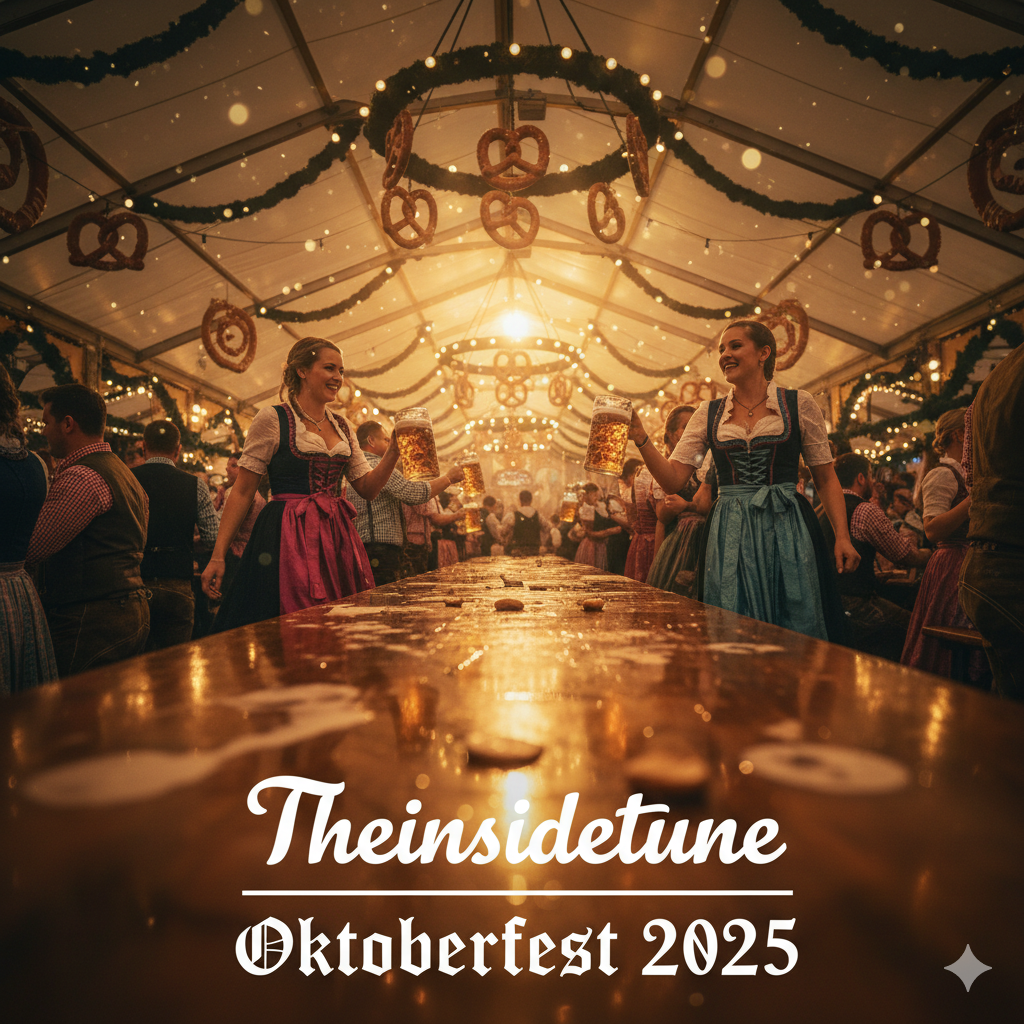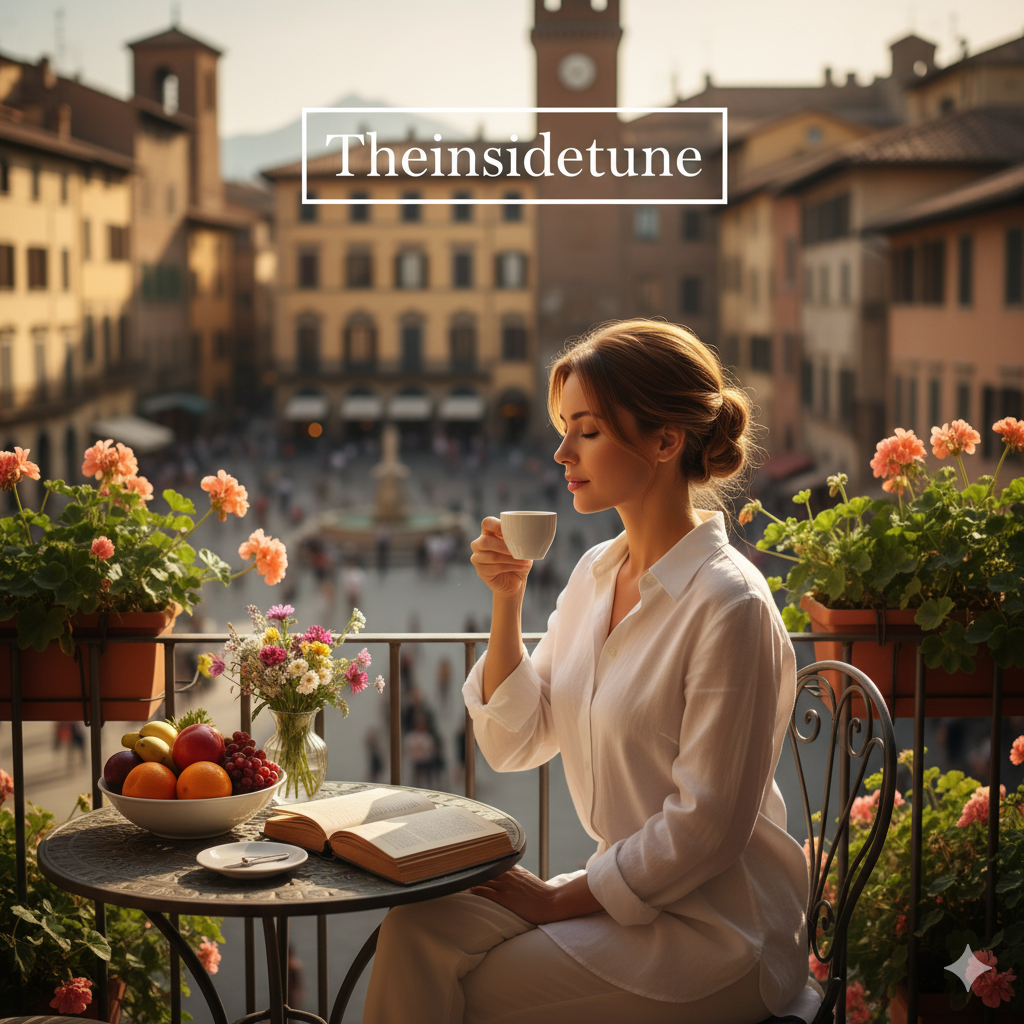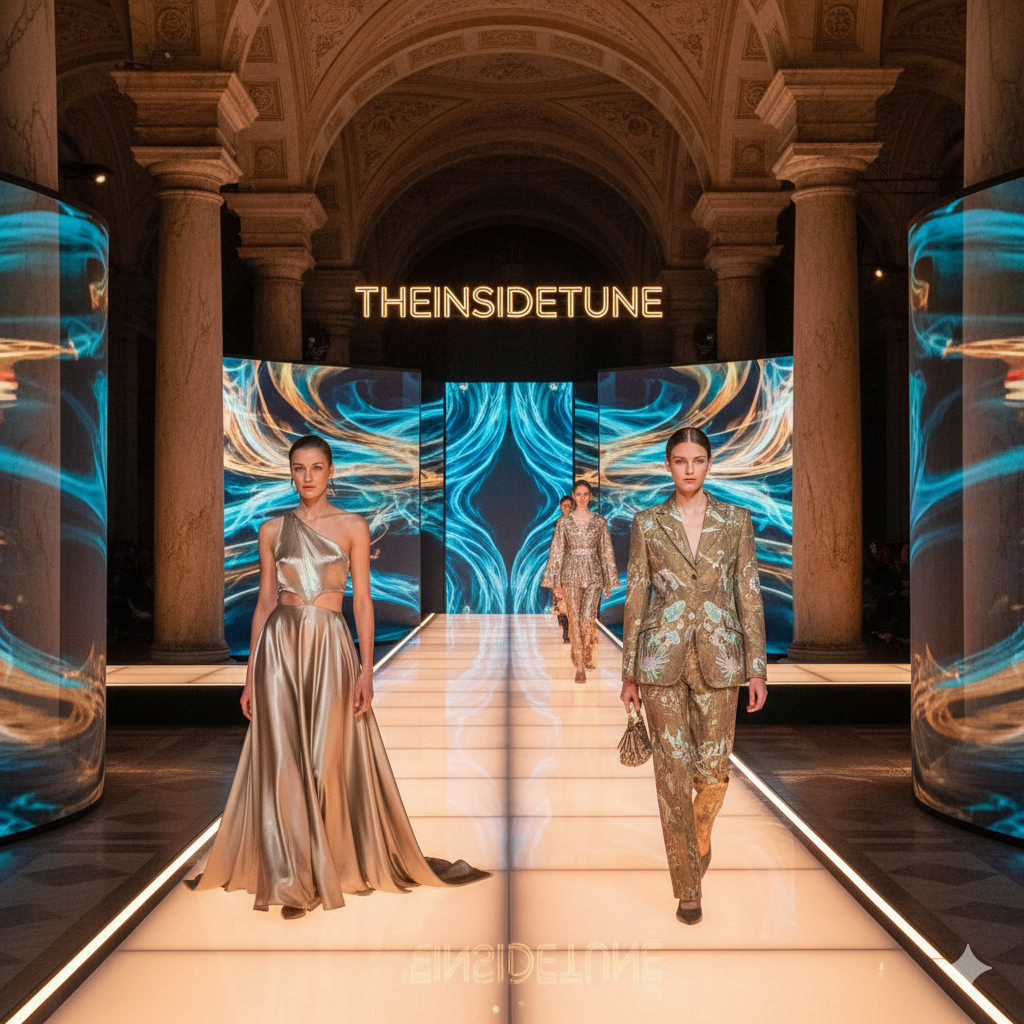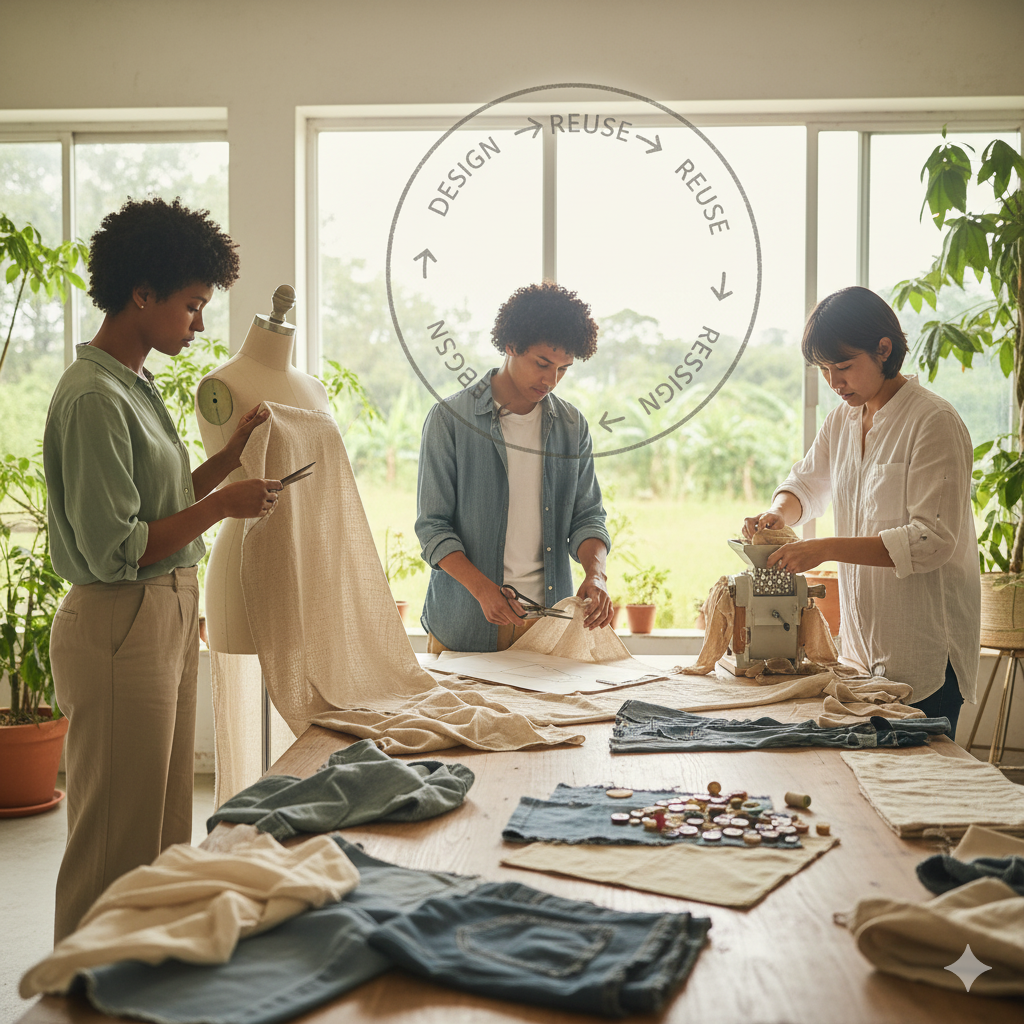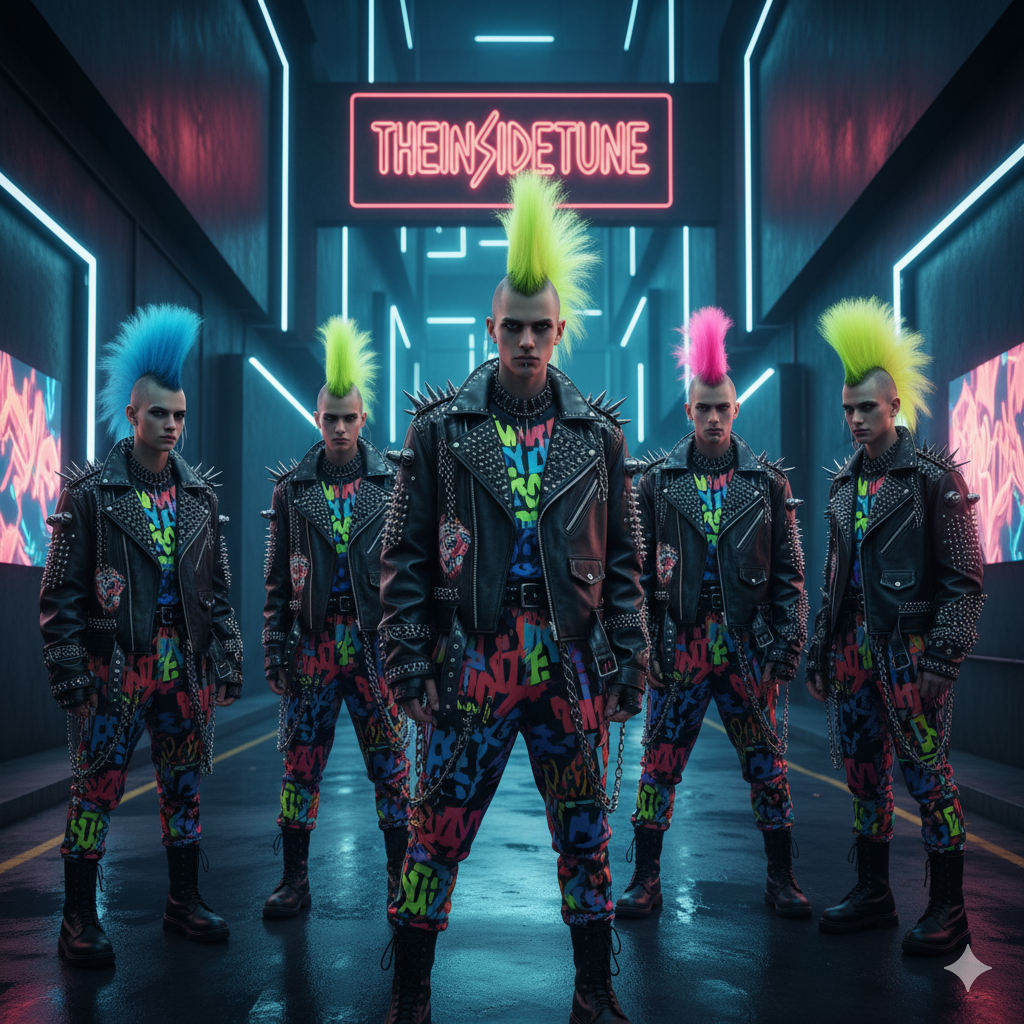Meta Description:
Oktoberfest 2025, WELCOME to a perfect guide for the world’s greatest event. If you are ready to unleash and heading to Munich for Oktoberfest. you have seen a cloud of people, wearing beautiful, traditional dresses. Discover your perfect outfit and enjoy the event with an amazing look. Learn to know Dirndl and Lederhosen styles, wearing the apron strings in a traditional way with modern European trends for an authentic, unforgettable experience.
1. Guide to Oktoberfest Attire: What to Wear in 2025 🥨🍻
One of the most exciting things about Oktoberfest is the blend of tradition, 80% people, both tourists and locals, especially wear an outfit with a traditional look
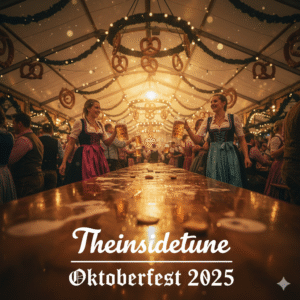
Prost!
Embracing the Spirit of Bavarian Tracht 🇩🇪
Before you start shopping, it’s essential to understand that what you’ll be wearing is called Tracht (pronounced “tr-ah-cht”), the traditional folk costume of the Alpine regions. The two most iconic forms of Tracht you’ll see at Oktoberfest are the Dirndl for women and Lederhosen for men. Wearing them is a way of connecting with history and celebrating a unique cultural identity.
From simple dress to festival special, The story of the Dirndl and Lederhosen is an amazing journey from humble workwear to celebrated cultural icons. These garments didn’t start as festive attire. Back in the 18th century, they were the practical, everyday clothing of peasants, farmers, and servants in the mountainous regions of Bavaria, Austria, and Switzerland.
Lederhosen, which translates to “leather breeches,” were made as durable work pants for men. Made from tough leather like deerskin or cowhide, they could resist the rigors of physical labor, hunting, and outdoor life, offering far more durability than simple fabric trousers. Similarly, the
Dirndl was originally a simple, sturdy work dress especially for maids and female farm laborers, made from practical materials like wool and cotton.The perception of these garments began to shift in the 19th century.
As industrialization advanced, new clothing like jeans became available, and Tracht started to be seen as old-fashioned and “uncultured” peasant clothing. However, this was followed by a remarkable reversal. The Bavarian nobility and upper classes began to romanticize rural life and adopted
Tracht for their free time activities, such as hunting and horseback riding. This aristocratic seal of approval transformed the humble workwear into fashionable, high-status attire.
Dirndls began to be crafted from luxurious fabrics like silk and satin, and Lederhosen became a stylish choice for the elite.
Just as this trend was diminishing, the garments faced near-depreciation once again. It was the rise when societies start to preserve culture in the 1880s that saved them from being lost to time. These groups, championed by Bavarian royalty like King Ludwig II, sought to preserve regional traditions.
The ultimate revival came in 1887, when Oktoberfest organizers officially declared the Dirndl and Lederhosen as the official attire for the festival. This act established their new identity: no longer workwear or a marker of social class, but a adorned symbol of Bavarian pride and celebration. This evolution explains why wearing
The Ultimate Dirndl Guide for Women 💃
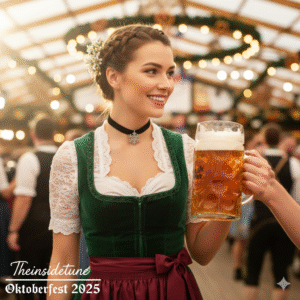
The Dirndl is an incredibly flattering and timelessly elegant outfit that looks beautiful on every body type. But a true Dirndl is more than just a dress; it’s an collection of several distinct pieces working together to create the iconic silhouette.
Deconstructing the Dirndl: The Four Essential Components
An authentic Dirndl outfit consists of four separate parts that you’ll purchase and assemble. Understanding each piece on your body type is the first step to creating your perfect look.
- The Dress (Bodice & Skirt): This is the primary part of the garment. It features a tight-fitting bodice, called a Mieder, which is designed to be form-fitting and create a corseted effect, accentuating the waist. Attached to the bodice is a full, wide skirt, or Rock, that is gathered or pleated at the waist. This combination creates the classic hourglass shape that makes the Dirndl so flattering.
- The Blouse (Bluse): Worn underneath the dress, the Dirndl blouse is a separate, cropped top that ends just below the bust. It’s typically white and serves to cover the shoulders and chest, with the neckline and sleeve style defining the overall look of the outfit. You cannot wear a Dirndl without a blouse; it’s considered a major faux pas.
- The Apron (Schürze): The apron is tied around the waist over the skirt. It adds a vibrant splash of color or pattern and is a key decorative element. Most importantly, the way you tie the bow of your apron sends a very specific social signal.
With the basics down, the fun begins. Modern Dirndls come in a dizzying array of styles, allowing you to express your personality and confidence. while, still honoring tradition.
Skirt Lengths Explained
The length of your Dirndl skirt is one of the crucial choices you’ll make. It says a lot about your approach to the festival and is a key indicator of an authentic-looking outfit. There are three main lengths :
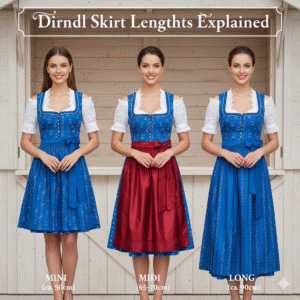
- Mini (approx. 50 cm): This length falls well above the knee. While available, it is strongly discouraged for an authentic Oktoberfest experience. It is widely considered inappropriate, touristy, and disrespectful to the tradition. Best to avoid this length entirely.
- Midi (approx. 65-70 cm): Falling at or just below the knee, this is the gold standard. The midi length is the most popular, traditional, and versatile choice for Oktoberfest. It’s elegant, comfortable for dancing, and universally flattering. Almost everyone at the festival wears a midi-length Dirndl.
- Long (approx. 90 cm): A full-length or maxi Dirndl that reaches the ankles is the most traditional and formal style. While beautiful, it is less common at the bustling beer tents and is typically reserved for more formal occasions like weddings or parades.
Blouse Styles for Every Taste
The blouse is where you can truly make your look. While classic white cotton with short, puffed sleeves is always a perfect choice, there are many other styles to explore :
- Necklines: You’ll find everything from traditional square and sweetheart necklines to romantic off-the-shoulder (Carmen) styles and elegant high-neck blouses, often made of lace. A V-neck can offer a slimming and feminine charm.
- Sleeves: Sleeve options range from classic short puff sleeves to elbow-length, three-quarter length, and even long sleeves for cooler weather. Lace and ruffled detailing are also very popular.
Choosing Flattering Colors & Fabrics
Traditionally, Dirndls were made from sturdy fabrics like cotton, linen, and wool, which are still excellent choices for comfort and authenticity. However, modern European fashion trends have introduced more luxurious materials like rich velvet, shimmering silk, and elegant satin, which add a touch of lavish to the outfit.
- Red: Symbolizes passion, love, and confidence. A bold choice for those who want to stand out.
- Blue: Represents loyalty, harmony, and fidelity. A classic and elegant choice, and as one of Bavaria’s official colors, it’s always appropriate.
- Green: Signifies nature, renewal, and a connection to the outdoors.
- Black: Conveys sophistication, power, and mystery. A chic and versatile option.
The Secret Language of the Dirndl Bow: Don’t Get it Wrong!
This is perhaps the single most important piece of Oktoberfest etiquette you need to know. The placement of the knot on your apron bow is a code that signals your relationship status. While this is a comparatively modern emphasis on an older, looser custom, it is taken very seriously today by locals and festival veterans alike. Getting it right is crucial to directing the social scene in the beer tents.
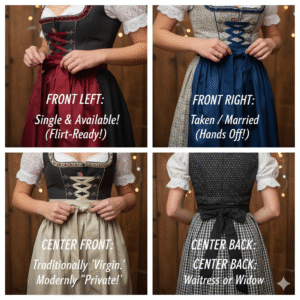
Here is a simple guide to tying your bow correctly, from the wearer’s perspective:
| Bow Position (From Your Perspective) | Meaning | Mnemonic / Tip |
| Tied on the Left | Single / Available for a flirt! | “Bow on the left brings luck!” |
| Tied on the Right | Taken / In a relationship / Married | “Right is for the wedding Ring.” |
| Tied in the Center Front | Traditionally: Virgin. Modernly: “It’s none of your business!” | Generally worn by young girls or those who prefer to keep their status private. |
| Tied in the Center Back | Waitress or Widow | Waitresses keep the front clear to carry trays and wallets. |
Finishing Touches: Dirndl Accessories & Hairstyles
The right accessories will elevate your Dirndl from a simple dress to a complete, polished outfit.
Accessories
- Shoes: Comfort is king! You’ll be doing a lot of walking, standing, and dancing on benches. Stilettos are a definite no. Opt for comfortable yet stylish footwear like ballet flats, low block heels, or traditional Mary Janes. Ankle boots are also a popular and practical choice, especially for cooler weather.
- Handbag: Large bags and backpacks are not allowed in the festival grounds. Choose a small handbag (Trachtentasche), often made of felt or leather and heart-shaped, that is just big enough for your essentials: cash, phone, and ID.
- Jewelry: Traditional Bavarian jewelry is the perfect finishing touch. A velvet choker necklace (Kropfband), often adorned with an Edelweiss pendant, is a classic choice. Simple charm bracelets and earrings also work well.
- Outerwear: Evenings in Munich can get chilly. A traditional knitted cardigan, known as a Trachtenjanker, is the perfect way to stay warm without compromising your look.
Hairstyles
Braids are the quintessential hairstyle for Oktoberfest. They are not only traditional but also practical, keeping your hair neatly out of your face during a long day of festivities.
Popular styles include :
- Braided Crown (Heiligenschein): A timeless and elegant style where braids are wrapped around the head like a halo.
- Classic Pigtails: Two simple braids, one on each side, often woven with ribbons.
- Fishtail Braid: A more intricate and modern take on the classic braid.
- Updos: Elegant buns and twists, often incorporating smaller braids.
Floral wreaths, ribbons, and delicate hairpins are beautiful additions to any of these styles.
Easy Step-by-Step Braided Crown (for medium to long hair):
- Part your hair down the middle and create two low pigtails, securing them with clear elastics.
- Braid each pigtail into a simple three-strand braid and secure the ends.
- Take one braid and pull it up and over the top of your head, like a headband. Pin it securely in place about an inch from your hairline using bobby pins.
- Take the second braid and wrap it over your head as well, tucking it just behind the first braid. Pin it securely.
- Adjust the braids so they sit comfortably, hide the ends, and finish with a light mist of hairspray for all-day hold.
Oktoberfest Fashion in 2025: Blending Tradition with European Trends
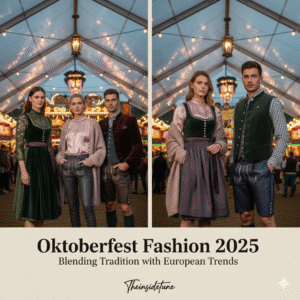
While the foundations of Tracht are rooted in centuries of history, the fashion is by no means static.
Each year, contemporary European fashion trends influence the styles you’ll see at the Wiesn. This evolution is crucial; it keeps the tradition alive and relevant, preventing it from becoming a dusty museum piece.
By adapting to modern tastes in color, fit, and fabric, Tracht remains a vibrant and dynamic form of cultural expression that new generations are excited to embrace. Here are the top trends to watch for in 2025
The New Color Palette
While classic checkered patterns and earthy tones will always be in style, the modern color palette is expanding over time.
- For Dirndls: Look for more sophisticated, muted tones alongside the bright classics. Soft, elegant hues like blush pink, sage green, and sky blue are very fashionable. Jewel tones like deep burgundy, plum, and navy blue are also popular, offering a rich and modern look. A major trend is the
tone-on-tone look, where the dress, apron, and even the blouse are all in different shades or textures of the same color, creating a chic, monochromatic effect. - For Lederhosen: While traditional browns and tans remain dominant, you’ll see more options in deep forest green, charcoal grey, and even navy blue, offering a contemporary twist on the classic.
Modern Silhouettes and Fabrics
The cut and material of Tracht are also evolving to reflect modern sensibilities.
- Slim-Fit Lederhosen: Younger festival-goers are increasingly opting for slim-fit Lederhosen. This modern cut offers a more tailored and refined silhouette compared to the traditionally looser fit, appealing to a contemporary fashion aesthetic.
- Luxurious Dirndl Fabrics: High-fashion influences are bringing luxurious materials to the forefront. Dirndls made from velvet, silk, and satin are increasingly popular, lending an air of sophistication and elegance to the traditional dress.
- Innovative Blouses: The simple white blouse is being joined by more daring designs. Look for colored blouses that create a bold color-blocking effect, as well as high-neck and off-the-shoulder styles made from intricate lace.
The Rise of Gender-Neutral & Sustainable Tracht
Two of the biggest movements in global fashion are also making their mark on Oktoberfest attire.
- Gender-Neutral Options: The lines are blurring, with more brands offering unisex and gender-fluid designs. Women wearing Lederhosen is now extremely common and fashionable. These are often cut with a more tailored, feminine fit and paired with a Dirndl blouse or a stylish top. You’ll also see more relaxed-fit, unisex Lederhosen designed to be worn by anyone.
- Sustainability: There is a growing focus on eco-conscious fashion. Brands are beginning to use sustainable materials like organic cotton for shirts and blouses, and even recycled or plant-based leather alternatives for Lederhosen, reducing the environmental impact without sacrificing style or quality.
Oktoberfest Attire Etiquette: The Dos and Don’ts ✅❌
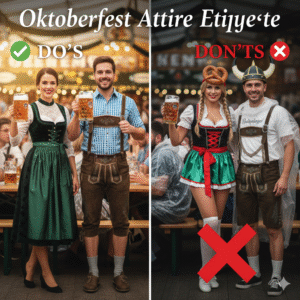
Participating in the tradition of wearing Tracht is a fantastic way to immerse yourself in the Oktoberfest experience. However, it’s important to do it respectfully. Following a few simple etiquette rules will ensure you look the part and are welcomed by the locals.
What NOT to Wear: Avoid These Common Tourist Mistakes!
The single most important rule is this: do not wear a cheap, novelty costume. Locals appreciate the effort when tourists dress up, but they can spot a poor-quality, disrespectful costume from a mile away. To avoid looking like an uninformed tourist, steer clear of:
- Anything from a party store or in a plastic bag. If it’s labeled “Beer Wench,” “Beer Garden Babe,” “Lederhosen Honey,” or “German Servant,” leave it on the shelf.
- Polyester or non-leather Lederhosen. The name literally means “leather breeches.” Faux-leather or fabric versions look cheap and inauthentic.
- Extremely short “mini” Dirndls. As mentioned, these are considered tacky and inappropriate. A respectful length is at or below the knee
- Wearing a Dirndl without a blouse. This is a major fashion crime in Bavaria.
- Comical hats. Avoid silly hats shaped like beer steins, chickens, or anything similar. They are not part of the tradition.
- T-shirts with printed-on Lederhosen or Dirndls. This is seen as mocking the tradition.
Wearing Tracht with Respect: A Guide for International Visitors
So, is it okay for a non-German to wear Tracht? The answer is a resounding YES! Tourists are warmly encouraged to participate. The concept of “cultural appropriation” is not a concern here; it’s a celebration you are invited to join. The key is to approach it with respect and appreciation, not as a joke or a costume party.
By investing in an authentic outfit—even a budget-friendly one made from proper materials—you are showing that you have taken the time to understand and honor the local culture. This effort is noticed and widely appreciated by Bavarians.
Where to Buy Authentic Outfits (For Every Budget)
You don’t need to spend a fortune to get a great, authentic outfit. There are excellent options available for every budget, both online and in Munich.
- Budget-Friendly (Under €150): You can find a decent, authentic outfit in this price range. Look for Lederhosen made from cowhide and Dirndls made from cotton. In Germany, large department stores like C&A or Galeria Kaufhof offer good quality, affordable options. Online, be cautious of suspiciously cheap deals on Amazon, but reputable budget-friendly retailers do exist. A decent Dirndl set will start around €80-€1
- Mid-Range (€150 – €400): This is the sweet spot for excellent quality and style. You can get high-quality goatskin Lederhosen and beautifully designed Dirndls in a variety of fabrics. In Munich, specialty stores like Angermaier and Daller Tracht offer a fantastic selection and expert advice.
- High-End (€400+): If you want to invest in a truly premium, heirloom-quality outfit, this is the range for you. This will get you the softest deerskin Lederhosen or a designer Dirndl made from silk or velvet. In Munich, Lodenfrey is the gold standard for luxury Tracht.
- Renting: While some places offer rentals, it’s generally not recommended. The cost can be nearly as much as buying a budget outfit, the selection is limited, and the hygiene can be questionable. Since you’ll likely want to wear your Tracht again, buying is almost always a better investment.
First-Timer’s Survival Guide: Beyond the Outfit 🍻
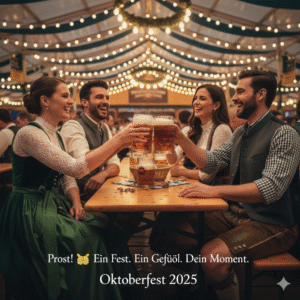
Now that you’re dressed for success, here are a few final tips to make your first Oktoberfest experience unforgettable.
- Bring Cash (Bargeld): While the world runs on cards, many of the beer tents at Oktoberfest are cash-only zones. To avoid a desperate search for an ATM, arrive with plenty of Euros.
- Pace Yourself (Langsam trinken): The beer served at Oktoberfest is a special, stronger brew called Märzen, typically around 6% ABV. It’s served in one-liter steins (Maß). It’s a marathon, not a sprint. Drink plenty of water and enjoy the hearty food to keep yourself going.
- Learn the Magic Word: “Prost!”: The bands in the tents play a song called “Ein Prosit der Gemütlichkeit” (A Toast to Coziness) roughly every 15-20 minutes. At the end, everyone raises their steins and cheers “Prost!” (Cheers!). Learning this simple chorus will make you feel right at home.
- Find a Seat: You can’t get served a beer unless you are seated at a table. Tents are free to enter, but finding an unreserved spot can be a challenge, especially on weekends. Arrive early or be prepared to politely ask groups if they have space.
- Enjoy the Whole Festival: Oktoberfest is more than just beer tents! The grounds, known as the Theresienwiese (or Wiesn for short), are home to a massive carnival with rides, games, food stalls, and incredible attractions like the historic Teufelsrad (Devil’s Wheel).
By embracing the traditional dress and spirit of the festival, you’re not just a spectator—you’re part of the celebration. Have an amazing time, be respectful, and make memories that will last a lifetime!

